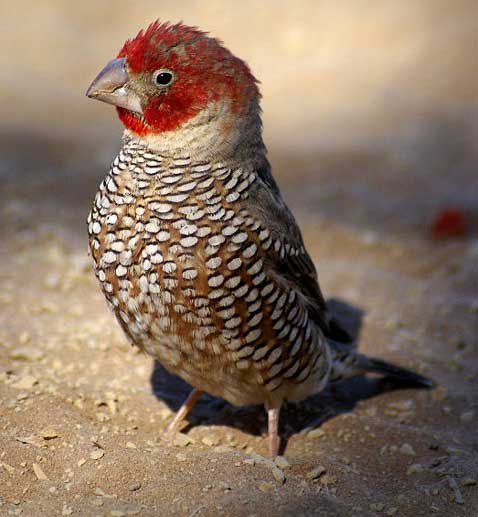
Amadina erythrocephala (*)
Superregnum: Eukaryota
Cladus: Unikonta
Cladus: Opisthokonta
Cladus: Holozoa
Regnum: Animalia
Subregnum: Eumetazoa
Cladus: Bilateria
Cladus: Nephrozoa
Superphylum: Deuterostomia
Phylum: Chordata
Subphylum: Vertebrata
Infraphylum: Gnathostomata
Megaclassis: Osteichthyes
Cladus: Sarcopterygii
Cladus: Rhipidistia
Cladus: Tetrapodomorpha
Cladus: Eotetrapodiformes
Cladus: Elpistostegalia
Superclassis: Tetrapoda
Cladus: Reptiliomorpha
Cladus: Amniota
Classis: Reptilia
Cladus: Eureptilia
Cladus: Romeriida
Subclassis: Diapsida
Cladus: Sauria
Infraclassis: Archosauromorpha
Cladus: Crurotarsi
Divisio: Archosauria
Cladus: Avemetatarsalia
Cladus: Ornithodira
Subtaxon: Dinosauromorpha
Cladus: Dinosauriformes
Cladus: Dracohors
Cladus: Dinosauria
Ordo: Saurischia
Cladus: Eusaurischia
Subordo: Theropoda
Cladus: Neotheropoda
Cladus: Averostra
Cladus: Tetanurae
Cladus: Avetheropoda
Cladus: Coelurosauria
Cladus: Tyrannoraptora
Cladus: Maniraptoromorpha
Cladus: Maniraptoriformes
Cladus: Maniraptora
Cladus: Pennaraptora
Cladus: Paraves
Cladus: Eumaniraptora
Cladus: Avialae
Infraclassis: Aves
Cladus: Euavialae
Cladus: Avebrevicauda
Cladus: Pygostylia
Cladus: Ornithothoraces
Cladus: Ornithuromorpha
Cladus: Carinatae
Parvclassis: Neornithes
Cohors: Neognathae
Cladus: Neoaves
Cladus: Telluraves
Cladus: Australaves
Ordo: Passeriformes
Subordo: Passeri
Infraordo: Passerida
Superfamilia: Passeroidea
Familia: Estrildidae
Genus: Amadina
Species: Amadina erythrocephala
Subspecies: A. e. dissita – A. e. erythrocephala
Name
Amadina erythrocephala (Linnaeus, 1758)
Original combination: Loxia erythrocephala
References
Linnaeus, C. 1758. Systema Naturae per regna tria naturæ, secundum classes, ordines, genera, species, cum characteribus, differentiis, synonymis, locis, Tomus I. Editio decima, reformata. Holmiæ: impensis direct. Laurentii Salvii. i–ii, 1–824 pp DOI: 10.5962/bhl.title.542: 172. Reference page.
Vernacular names
العربية: حسون أحمر الرأس
català: Teixidor cap-roig
Deutsch: Rotkopfamadine
English: Red-headed Finch
español: Estrilda cabecirroja
فارسی: سهره سرسرخ
suomi: Suomuviiltopeippo
français: Amadine à tête rouge
magyar: Vörösfejű amandina
italiano: Amadina testarossa
Nederlands: Roodkopamadine
português: Degolado-de-cabeça-vermelha
русский: Красноголовая амадина
svenska: Rödhuvad amadin
Türkçe: Kırmızı başlı ispinoz
українська: Червоноголова амадина
中文: 紅頭環喉雀
The red-headed finch (Amadina erythrocephala) (also known as the paradise finch) is a common species of estrildid finch found in Africa. It has an estimated global extent of occurrence of 1,600,000 km2. It is found in Angola, Botswana, Lesotho, Namibia, South Africa and Zimbabwe.
Males have vibrant red heads and chests while the females are duller. The resemblance to the cut-throat finch is unmistakable. The red-headed and cut-throat finch are the only members of the genus Amadina. Amadinas with their heavy beaks resemble members of the Lonchura, so they are actually more closely related to the Pytilias such as the Melba finch.[2]
Taxonomy
The red-headed finch was formally described by the Swedish naturalist Carl Linnaeus in 1758 in the tenth edition of his Systema Naturae under the binomial name Loxia eryocephala, a misspelling of Loxia erythrocephala.[3][4] The specific epithet combines the Ancient Greek eruthros meaning "red" with -kephalos meaning "headed".[5] Linnaeus based his description on "The Sparrow of Paradise" that had been described and illustrated in 1751 by the English naturalist George Edwards in his A Natural History of Uncommon Birds. Edwards' specimen had been collected in Angola.[6] This species is now placed with the cut-throat finch in the genus Amadina that was introduced in 1827 by the English naturalist William John Swainson.[7][8] The species is monotypic: no subspecies are recognised.[8]
Behaviour
Often seen in small flocks on dry savannahs, the red-headed finch is a ground feeder which feeds companionably with other species and often visits waterholes. It has a distinctive double-noted chuck-chuck call.[9]
References
BirdLife International (2016). "Amadina erythrocephala". IUCN Red List of Threatened Species. 2016: e.T22719932A94652129. doi:10.2305/IUCN.UK.2016-3.RLTS.T22719932A94652129.en. Retrieved 12 November 2021.
"The Red Head Finch - Amadina erythrocephala".
Linnaeus, Carl (1758). Systema Naturae per regna tria naturae, secundum classes, ordines, genera, species, cum characteribus, differentiis, synonymis, locis (in Latin). Vol. 1 (10th ed.). Holmiae (Stockholm): Laurentii Salvii. p. 172.
Paynter, Raymond A. Jr, ed. (1968). Check-List of Birds of the World. Vol. 14. Cambridge, Massachusetts: Museum of Comparative Zoology. p. 388.
Jobling, James A. (2010). The Helm Dictionary of Scientific Bird Names. London: Christopher Helm. p. 149. ISBN 978-1-4081-2501-4.
Edwards, George (1751). A Natural History of Uncommon Birds. Vol. Part IV. London: Printed for the author at the College of Physicians. p. 180.
Swainson, William John (1827). "On several groups and forms in ornithology, not hitherto defined". Zoological Journal. 3: 343–363 [349].
Gill, Frank; Donsker, David; Rasmussen, Pamela, eds. (January 2021). "Waxbills, parrotfinches, munias, whydahs, Olive Warbler, accentors, pipits". IOC World Bird List Version 11.1. International Ornithologists' Union. Retrieved 10 July 2021.
Newman, K. Newman's Birds of Southern Africa. ISBN 1-86812-278-6. p. 428.
Newman, K. Newman's Birds of Southern Africa. ISBN 1-86812-278-6. p. 428.
Retrieved from "http://en.wikipedia.org/"
All text is available under the terms of the GNU Free Documentation License

